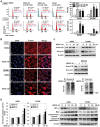A novel histone deacetylase inhibitor exhibits antitumor activity via apoptosis induction, F-actin disruption and gene acetylation in lung cancer
- PMID: 20856855
- PMCID: PMC2939045
- DOI: 10.1371/journal.pone.0012417
A novel histone deacetylase inhibitor exhibits antitumor activity via apoptosis induction, F-actin disruption and gene acetylation in lung cancer
Abstract
Background: Lung cancer is the leading cause of cancer mortality worldwide, yet the therapeutic strategy for advanced non-small cell lung cancer (NSCLC) is limitedly effective. In addition, validated histone deacetylase (HDAC) inhibitors for the treatment of solid tumors remain to be developed. Here, we propose a novel HDAC inhibitor, OSU-HDAC-44, as a chemotherapeutic drug for NSCLC.
Methodology/principal findings: The cytotoxicity effect of OSU-HDAC-44 was examined in three human NSCLC cell lines including A549 (p53 wild-type), H1299 (p53 null), and CL1-1 (p53 mutant). The antiproliferative mechanisms of OSU-HDAC-44 were investigated by flow cytometric cell cycle analysis, apoptosis assays and genome-wide chromatin-immunoprecipitation-on-chip (ChIP-on-chip) analysis. Mice with established A549 tumor xenograft were treated with OSU-HDAC-44 or vehicle control and were used to evaluate effects on tumor growth, cytokinesis inhibition and apoptosis. OSU-HDAC-44 was a pan-HDAC inhibitor and exhibits 3-4 times more effectiveness than suberoylanilide hydroxamic acid (SAHA) in suppressing cell viability in various NSCLC cell lines. Upon OSU-HDAC-44 treatment, cytokinesis was inhibited and subsequently led to mitochondria-mediated apoptosis. The cytokinesis inhibition resulted from OSU-HDAC-44-mediated degradation of mitosis and cytokinesis regulators Auroroa B and survivin. The deregulation of F-actin dynamics induced by OSU-HDAC-44 was associated with reduction in RhoA activity resulting from srGAP1 induction. ChIP-on-chip analysis revealed that OSU-HDAC-44 induced chromatin loosening and facilitated transcription of genes involved in crucial signaling pathways such as apoptosis, axon guidance and protein ubiquitination. Finally, OSU-HDAC-44 efficiently inhibited A549 xenograft tumor growth and induced acetylation of histone and non-histone proteins and apoptosis in vivo.
Conclusions/significance: OSU-HDAC-44 significantly suppresses tumor growth via induction of cytokinesis defect and intrinsic apoptosis in preclinical models of NSCLC. Our data provide compelling evidence that OSU-HDAC-44 is a potent HDAC targeted inhibitor and can be tested for NSCLC chemotherapy.
Conflict of interest statement
Figures







Similar articles
-
Mitochondrial apoptosis and FAK signaling disruption by a novel histone deacetylase inhibitor, HTPB, in antitumor and antimetastatic mouse models.PLoS One. 2012;7(1):e30240. doi: 10.1371/journal.pone.0030240. Epub 2012 Jan 18. PLoS One. 2012. PMID: 22279574 Free PMC article.
-
Efficacy of a novel histone deacetylase inhibitor in murine models of hepatocellular carcinoma.Hepatology. 2007 Oct;46(4):1119-30. doi: 10.1002/hep.21804. Hepatology. 2007. PMID: 17654699
-
Superior efficacy of co-treatment with the dual PI3K/mTOR inhibitor BEZ235 and histone deacetylase inhibitor Trichostatin A against NSCLC.Oncotarget. 2016 Sep 13;7(37):60169-60180. doi: 10.18632/oncotarget.11109. Oncotarget. 2016. PMID: 27507059 Free PMC article.
-
The natural tumor suppressor protein maspin and potential application in non small cell lung cancer.Curr Pharm Des. 2010 Jun;16(16):1877-81. doi: 10.2174/138161210791208974. Curr Pharm Des. 2010. PMID: 20337574 Free PMC article. Review.
-
MicroRNAs in non-small cell lung cancer: Gene regulation, impact on cancer cellular processes, and therapeutic potential.Pharmacol Res Perspect. 2019 Dec;7(6):e00528. doi: 10.1002/prp2.528. Pharmacol Res Perspect. 2019. PMID: 31859460 Free PMC article. Review.
Cited by
-
Knockdown of RBBP7 unveils a requirement of histone deacetylation for CPC function in mouse oocytes.Cell Cycle. 2014;13(4):600-11. doi: 10.4161/cc.27410. Epub 2013 Dec 6. Cell Cycle. 2014. PMID: 24317350 Free PMC article.
-
Epigenetic therapy in lung cancer.Front Oncol. 2013 May 30;3:135. doi: 10.3389/fonc.2013.00135. eCollection 2013. Front Oncol. 2013. PMID: 23755372 Free PMC article.
-
Functional Roles of Acetylated Histone Marks at Mouse Meiotic Recombination Hot Spots.Mol Cell Biol. 2017 Jan 19;37(3):e00942-15. doi: 10.1128/MCB.00942-15. Print 2017 Feb 1. Mol Cell Biol. 2017. PMID: 27821479 Free PMC article.
-
Combination therapy with butyrate and docosahexaenoic acid for keloid fibrogenesis: an in vitro study.An Bras Dermatol. 2017 Mar-Apr;92(2):184-190. doi: 10.1590/abd1806-4841.20176198. An Bras Dermatol. 2017. PMID: 28538876 Free PMC article.
-
Histone deacetylase inhibitor AR-42 enhances E7-specific CD8⁺ T cell-mediated antitumor immunity induced by therapeutic HPV DNA vaccination.J Mol Med (Berl). 2013 Oct;91(10):1221-31. doi: 10.1007/s00109-013-1054-9. Epub 2013 May 29. J Mol Med (Berl). 2013. PMID: 23715898 Free PMC article.
References
-
- Danesi R, de Braud F, Fogli S, de Pas TM, Di Paolo A, et al. Pharmacogenetics of anticancer drug sensitivity in non-small cell lung cancer. Pharmacol Rev. 2003;55:57–103. - PubMed
-
- Yang P, Allen MS, Aubry MC, Wampfler JA, Marks RS, et al. Clinical features of 5,628 primary lung cancer patients: experience at Mayo Clinic from 1997 to 2003. Chest. 2005;128:452–462. - PubMed
-
- Pfister DG, Johnson DH, Azzoli CG, Sause W, Smith TJ, et al. American Society of Clinical Oncology treatment of unresectable non-small-cell lung cancer guideline: update 2003. J Clin Oncol. 2004;22:330–353. - PubMed
-
- Stinchcombe TE, Socinski MA. Current treatments for advanced stage non-small cell lung cancer. Proc Am Thorac Soc. 2009;6:233–241. - PubMed
-
- Sandler A, Gray R, Perry MC, Brahmer J, Schiller JH, et al. Paclitaxel-carboplatin alone or with bevacizumab for non-small-cell lung cancer. N Engl J Med. 2006;355:2542–2550. - PubMed
Publication types
MeSH terms
Substances
LinkOut - more resources
Full Text Sources
Medical
Molecular Biology Databases
Research Materials
Miscellaneous

